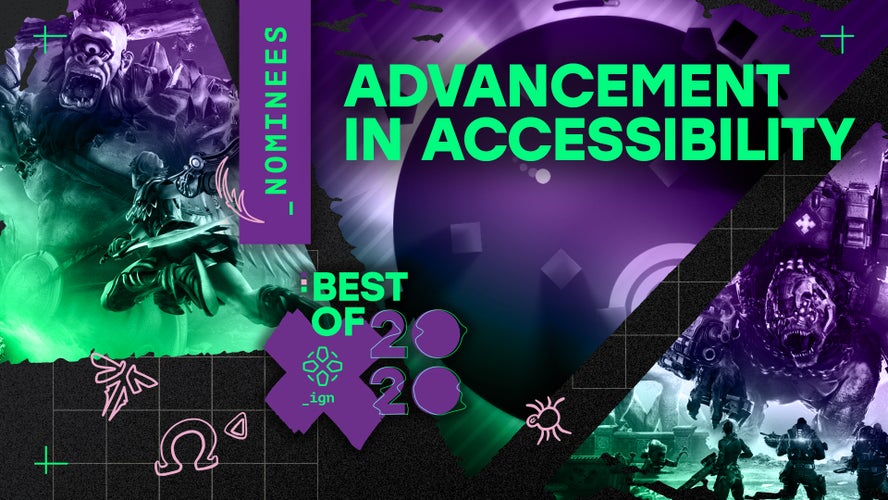October marks the one-year anniversary of Microsoft and Sony releasing the current generation of consoles. The Xbox Series X/S and PS5 bring with them powerful new hardware, as well as libraries of titles that benefit from faster loading speeds and special features like Quick Resume or the haptics of the DualSense. With new systems comes the potential to innovate in making gaming not just faster or more tactile, but just as importantly more accessible, too.
Xbox has notably endeavored to make accessibility advancements part of its mission since before the launch of the Xbox Series X and S. From the launch of the Xbox Adaptive Controller, to several new accessibility updates and features for its systems recently unveiled during Disability Awareness Month in October, Xbox is building an accessible gaming package that many disabled players will gravitate toward. Speaking with IGN, Xbox accessibility leads discussed the company’s journey so far in building a more accessible platform, the work still left to be done to make all of gaming more accessible, and the hopes for better cooperation across the industry to achieve that future.
The Evolution of Xbox’s Accessibility
Accessibility at first-party studios is not new, as systems have included console-wide accessibility as early as 2015. Yet, progress is relatively incremental aside from Xbox’s latest updates and announcements. Both PlayStation and Xbox allow players to fully customize controls, regardless of a specific game’s inputs, though these customization options existed during the previous generation and have largely been untouched since their initial release. The Nintendo Switch takes this feature a step further with five custom controller profiles for each official Nintendo controller. Other notable accessibility options included at a hardware level or present in most games are zoom features, text to speech and the capability to reduce screen movements and motions. But Xbox is creating new features to help distinguish their accessibility from competitors, and, hopefully, push the entire industry to find new ways to innovate..
Speaking with IGN, Director of Accessibility at Xbox Anita Mortaloni notes the progressive evolution of accessibility, especially with consoles.
“We know that accessibility is a journey, and we are just getting started, and there is still a lot to do, and a lot that we can continue to do even on the Xbox Adaptive Controller,” Mortaloni said.
One of the new innovations she discussed is the Game Accessibility Feature Tags system. According to an official post by Xbox, the store page will now display what accessibility features are present in a game. Tags like “Narrated Game Menus, Subtitle options, Input Remapping, Full keyboard support, and Single Stick Gameplay” will provide disabled players with a brief synopsis of what to expect to help inform their purchase decisions. Currently, only 20 tags are present, but Xbox intends to build Feature Tags into a more comprehensive system as it gains feedback from disabled players and developers.
“The number one question that we have continued to get is ‘What game can I play,’” Mortaloni said. “We wanted to make it really easy for gamers to find the next game they will love and be able to play. On top of the fact that it’s frustrating to have to do all of that research to begin with, you don’t want to purchase or download a game, and minutes in, or seconds, find out you can’t play it.”
The capability to check features is beneficial beyond those opening minutes of a game, too. Often, disabled players will struggle to complete a section or boss encounter far beyond the rare refund request period some platforms offer. Mortaloni notes it’s frustrating for disabled individuals to play “…99 percent through, [only to] find out you can’t finish that final boss fight because a feature is not there.”
Feature Tags are a great way to inform disabled consumers about potential barriers and their accessible solutions, but they still don’t give disabled players an ability to play more games. Currently, the Xbox Adaptive Controller is the only first-party developed piece of tech available intentionally created to assist disabled individuals. Yet, the device, famously equipped with the tagline “When everyone plays, we all win,” primarily benefits those with motor disabilities, a fraction of the total number of disabilities that exist. For disabled individuals with limited reach or limited motor function, the Adaptive Controller is a superb piece of tech. But for people who are sightless or have limited sight, or deaf and hard of hearing gamers, there’s room for more options to be created, rather than the Adaptive Controller existing as the only focus of accessibility enhancing hardware. And that’s a problem Xbox seems keenly aware of.
“
Xbox Game Studios Accessibility Lead, and Gaming and Disability Lead Tara Voelker notes the need to continue searching for and developing accessible tech for disabled players beyond motor disabilities.
“Xbox has already been taking its first steps to improve accessibility beyond the Adaptive Controller by incorporating our learnings back into our other products,” Voelker said. “Even if you look at the Xbox Series X|S Controllers, we made a concerted effort to expand it to more people by adjusting the size and ergonomics. Going forward, we still have a lot to think about. The Xbox Adaptive Controller is a product that was developed to address the needs of a specific set of gamers, those affected by certain motor disabilities. To really improve our tech, we need to look at gamers that still aren’t having their needs met and ask why. Once we understand the challenges these gamers are having, we can attempt to solve it by creating new, innovative products.”
Xbox’s Wish for Industry-wide Inclusion
Xbox’s lack of accessible tech for individuals besides those with motor disabilities is indicative of a greater issue across the industry – the need for inclusive devices like controllers. While the Xbox Adaptive Controller is immensely beneficial for physically disabled individuals, there’s one problem it, nor other Xbox accessibility advancements, can specifically handle.
The Adaptive Controller is the only accessible first-party controller on the market, and it’s only operational with Microsoft systems. While the massively popular Switch offers several controllers and the capability to position them in unique ways, their button layout and strength required to press buttons cannot be modified. And PlayStation games made specifically for the PS5 can only be played with a DualSense. Until the rest of the industry designs accessible controllers, Xbox and Windows are the only platforms that offer a controller for those with varying motor disabilities. And while third-party workarounds exist, there’s no uniformly agreed upon technology, so consistency of quality and depth of uses can drastically vary from one controller to the next.
One way of mitigating these inconsistencies, and opening up more consoles to having accessible controller options, could be for companies to begin working together and sharing their knowledge bases. And while this isn’t a direct comparison, Xbox-published games like Minecraft, Psychonauts 2, and more are available on other company’s platforms, and Xbox-owned characters have appeared in Super Smash Bros. Ultimate, demonstrating that companies are at the very least starting to chip away at the walls we normally think of when it comes to PlayStation, Xbox, and Nintendo.
“I would love the gaming industry to form partnerships so that accessible tech can be used on more platforms with minimal effort on the part of players,” Voelker said. “I’d love to be in a world where gamers pick the controller that is right for them (whether it’s the Xbox Adaptive Controller, the HORI Flex, or something else of their choosing) and they can use it to play wherever they want. I’d also love to see the industry working together as a whole to figure out how we can drive down the cost of assistive technology so that more people can afford to get the best gaming experience.”
Voelker’s wish for accessible partnerships across multiple studios highlights one of the ultimate barriers that disabled people encounter when playing console games – exclusivity. While accessible features can be universally baked into platforms, such as subtitles, remappable controls and colorblind filters, the tech behind these features continues to remain exclusive or be built separately into specific platforms. And when there is only one first-party accessible controller, individuals with motor disabilities are only left with one option.
“
“I don’t think competition is necessary to fuel innovation in accessibility,” Anita Mortaloni said. “Accessibility is one of those fields [where] 1+1=3. Yes, we can all totally do a whole lot individually, but when we come together, and partner and share ideas, be it across companies or with the community, we get a lot more done, and we are able to advance the industry a lot farther.”
Innovation is commonplace within the gaming industry. As studios continue to develop powerful new systems, pieces of tech that complement new games are sure to follow. Yet, for disabled individuals, there still remains a lack of software and hardware designed specifically to assist disabled individuals when facing unnecessary and unintentional gameplay barriers. Until more disabilities are represented with better console accessibility and pieces of tech, the gaming industry cannot be truly inclusive. Xbox’s strive to provide continuous support to disabled players is indicative of an industry that is willing to change. And as Mortaloni notes, industrywide collaboration for accessibility is necessary, and hopefully Xbox’s focus can encourage others to follow in its footsteps.
“There is no benefit to keeping it to ourselves. We all win when more people know about it, and understand it, and include it….”
Grant Stoner is a freelance writer for IGN. You can find him on Twitter.
Source: https://www.ign.com/articles/xbox-gaming-accessibility-advancements-controllers-ui
- '
- "
- 2020
- 7
- accessibility
- Advancement
- All
- Announcements
- barriers
- beneficial
- benefits
- BEST
- build
- Building
- change
- chip
- collaboration
- community
- Companies
- comparison
- competition
- competitors
- Consumers
- continue
- continues
- controller
- Creating
- Current
- develop
- developed
- developers
- developing
- Devices
- Director
- Disability
- Early
- evolution
- Exclusive
- Expand
- experience
- experts
- facing
- Feature
- Features
- Fields
- Figure
- filters
- First
- Focus
- follow
- form
- Forward
- freelance
- Fuel
- full
- function
- future
- game
- gameplay
- Gamers
- Games
- Gaming
- Gaming Industry
- great
- Group
- haptics
- Hardware
- How
- HTTPS
- i
- image
- importantly
- improve
- industry
- Innovation
- innovative
- IT
- journey
- judges
- keeping
- Keyboard
- knowledge
- large
- latest
- launch
- lead
- Level
- Limited
- love
- Making
- Market
- Microsoft
- Minecraft
- Mission
- Navigation
- New Features
- Nintendo
- Nintendo Switch
- offer
- Offers
- official
- open
- Option
- Options
- Other
- partner
- partnerships
- Patents
- People
- platform
- Platforms
- play
- players
- Playing
- playstation
- Popular
- potential
- present
- press
- Product
- Products
- Profiles
- progressive
- ps5
- purchase
- quality
- reduce
- research
- REST
- s
- Screen
- Series
- set
- Share
- Size
- So
- Software
- Solutions
- SOLVE
- Sony
- started
- stoner
- store
- support
- Switch
- system
- Systems
- tech
- Technology
- text
- The
- top
- unique
- Updates
- Video
- video games
- Vote
- What
- WHO
- win
- windows
- within
- Work
- workarounds
- world
- writer
- X
- xbox
- Xbox Series X
- year
- youtube
- zoom






